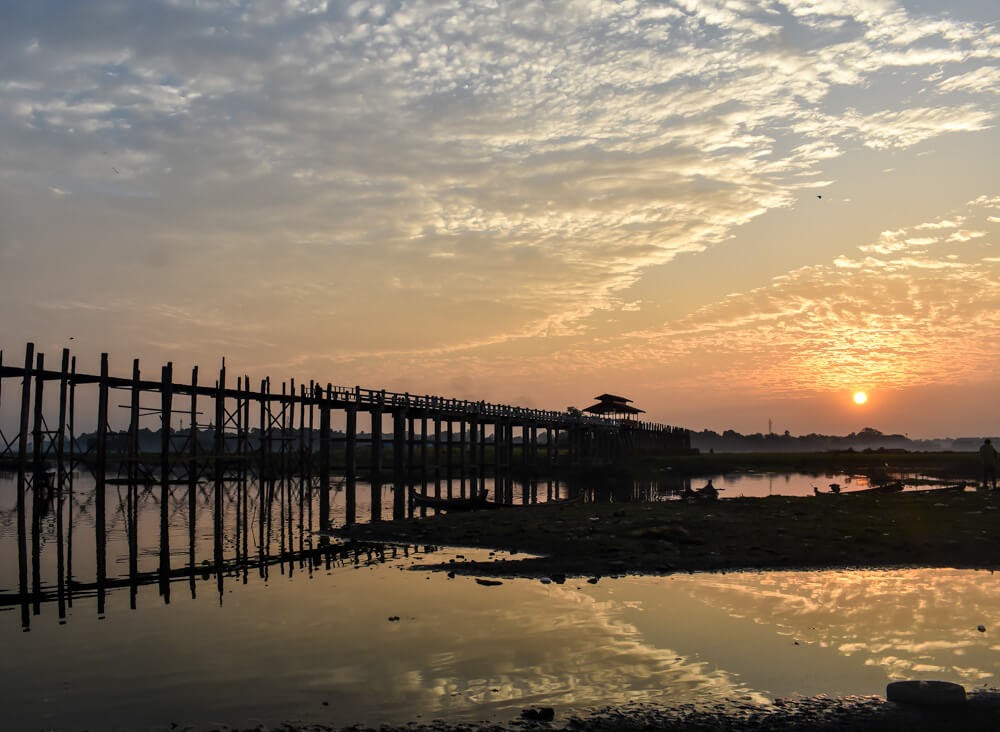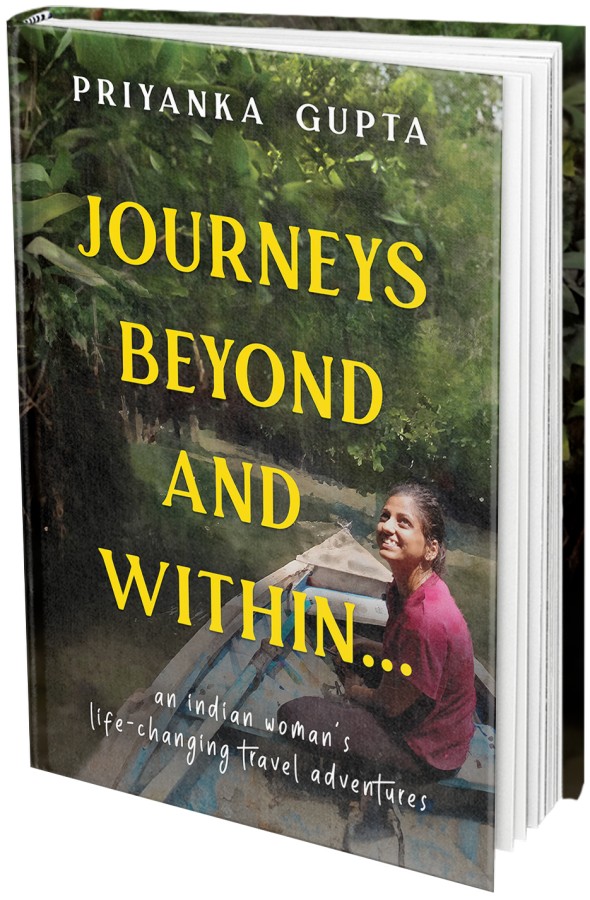A Travelogue of the U Bein Bridge, Myanmar
U Bein Bridge is in a township of Mandalay called Amarapura, which was once the royal capital of Myanmar.
Amarapura, literally the city of immortality in Pali(अमरपुर in Hindi), was the capital from 1783 until 1857, for almost 75 years. In 1857, when entire India was about to burst into its first revolt against the British East India Company, Burma’s King Mindon was building Mandalay as his new capital.
In the construction of the capital, the King wanted to use the old material from Amarapura as the second Anglo-Burmese war, (in which many Indian soldiers fought as one can see the graves of the sepoys in a Yangon cemetery), hadn’t left the royal treasure in blooming conditions. Elephants obeyed their king’s wish by hauling the building material over the 11-kilometer distance between Amarapura and Mandalay.
U Bein bridge, a 1.2 kilometer-long teak bridge, spanning Taungthaman Lake, was built during this move by the then-mayor U Bein. He put the 1000 or so Burma teak columns from the royal palace to good use as one can see in the picture above and below.
We are not talking about Mumbai’s sea link or the US’s Golden Gate bridge, but this footbridge is the oldest teak bridge in the world. (And contrary to popular belief, perhaps not the longest wooden bridge as Guinness World Record says Horai Japanese bridge holds this title.). Taking the name from the mayor, the U Bein bridge has already stood sturdy for about 170 years with only some of its wooden logs replaced by concrete.
U (in the mayor’s name) here serves as a respectful prefix, something like Sir, or maybe Lord. I request the Burmese readers to please let me know the real implications of U in the comments.
I was at the U Bein Bridge on a cold December morning. As it was the dry season of Burma, the water level of the lake was low. I have heard that in monsoon(June-September), the water from the lake almost kisses the bridge.
I often say, when in Burma, do as the Burmese, and rise before the sun kisses the sky yellow. As my friend and I had decided to spend that December dawn at the popular Burma bridge, we brushed and plonked our sleepy selves in a kind tuk-tuk.
When we arrived at the West end of the bridge in Amarapura, tourists and locals had already starting to flock. Swarms of crows were flying out and about. The faintly blue sky was studded with light clouds that the rising sun filled up with an orangish hue.
It was almost as if someone had dropped a dollop of orange on an otherwise white pool.
Related Read: Exploring Inle Lake, Burma
I couldn’t miss the hoards of tourists who had stationed themselves on the lake’s west bank to click the pictures of a fisherman. The entertainer was putting on a show by casting the fishing net in the lake. The travelers, mostly Chinese, captured his every move, and one could sync the click-click of the camera shutter with the fisherman’s muscle movement.
On that note let me tell you that more than 220,000 Chinese travelers had visited Mandalay city through January to April 2019: an increase that irritated locals in a way that it was published in the Myanmar Times.
Well, we can’t blame the tourists here as all credits for the showmanship go to the Burmese fish guy. Once, I was taught how to throw the fishing net by a Malaysian man on the banks of the Kinabatangan river. And as you can expect, I failed, horribly. My teacher, though, caught small fishes in his first throw just minutes after my embarrassing display of clumsy body movements.
If you see wooden boats on the West end of the bridge, you can request the boatman to take you on a ride on the lake. I don’t know how much the ride costs, but well, you are in Myanmar.
I didn’t hop on a boat. As I moved my attention from the drama, I saw that the sun was coming up the horizon. After taking a few photographs of the sunrise behind the bridge from different angles, I climbed up.
Soon I was surrounded by the many locals, tourists, vendors, and monks, who were all starting their day, along with me, at the Mandalay bridge. Some were exercising, some were photographing, some paced up to the other end, and the others were just hanging out.
I saw many photoshoots in that hour or two when I was at the top. Couples were getting clicked together. Some dressed in Elvis Presley-ish clothes were photographing each other in turns. And a few, like me, wanted to capture others’ lives on their camera roll.
Though all the articles on the internet suggest seeing a U Bein bridge sunset, I found the sunrise there quite calming, and, of course, gorgeous. As a result of the internet advice, the number of people at dawn was definitely lesser than the number of people who would head to the bridge in the evening.
For us, travelers, the bridge was all about sightseeing. But the locals have been using the bridge to go from one end of the lake to the other for more than a hundred years now. Children go to school by walking across the bridge. Monks go asking for alms via the bridge. Men and women get to their work, some of them carrying bamboo baskets over their heads, through the bridge. Some locals were even on bicycles giving the photographers a perfect silhouetted shot while the bridge lay spanned across the lake.
The reflection of the sun and the bridge in the lake water caught my eye. So after we had clicked and rested and relaxed in all lengths of the bridge, we got down to walk around the lake.
While we strolled under the bridge, we found small restaurants and snack shops run by locals. One such restaurant not only served as a quick tea joint but saved two homeless travelers by giving the keys to their bathroom which we used to full advantage.
The girls from the restaurant helped us wash our hands by pouring water, and I was suddenly sent back to my parent’s home.
In my small hometown, we lived traditionally and wouldn’t even touch the tap with our potty hands(excuse me for the childish language but I believe I never grew up for that is how I still refer to this business.). And when I say potty hands, I am being literal for we used traditional Indian style, or squat, toilets. Neither did we know about toilet papers nor did we have hand showers that most of us can’t live without.
In the absence of a better tool, we cleaned ourselves by throwing water from a mug, and if need be, used our hands, too. I would spare you further details as Wikihow has explained this process generously. When one family member would exit the bathroom, the other would come with the precious jugful of water. The culprit would lather her hands with soap, and the helper would pour the holy water.
No one judged because soon it would be the turn of the other person.
And that happily forgotten childhood scene was repeating now. The only difference being that I had wiped myself with toilet paper, my hands were clean, and instead of my family, two young, benevolent, but giggly, Burmese girls were washing my hand while their mother, also giggly, instructed them from the background.
Friends, always carry toilet paper in Burma.
After this long toilet saga, I would not feel bad if you leave this travelogue right now. But what are travel stories without a bit of truth? Haven’t you ever been stuck abroad in a toilet without any toilet paper or a hand shower and no one to call? What did you do? And let us not blame Asia. My Airbnb host in Kelsterbach, Germany forgot to keep the toilet paper in the bathroom, and what followed on that period day is a story that I will tell in another lifetime.
Life was slow in that family-run food shop. And I can’t even imagine how it would be to run a restaurant under a bridge. But with the lake and the stunning nature shows and lost travelers looking for the toilet, it wouldn’t be that bad?
Now feeling fresh, we walked to the Amarapura market near the bridge hoping to eat.
My friend had been hypnotized by the Shan noodles. So when we asked about them at a family-run food shop, and a little boy nodded, we ran inside.
I would tell you more about Shan noodles in upcoming Burma stories, but for now, I thank Burma for introducing me to the great Shan noodles. I even bought a few packets of the noodles from the San Bogyoke Market in Yangon and now I make them back home in India. Just fry some garlic in oil, add chunky tomatoes, some spices, and add this to boiled Shan noodles. Voila.
We ate Shan soup, snacked on the tea leaf salad, and sipped herbal tea. Soon the restaurant filled with families and some more giggling and smiling ensued.
What a morning it was! And as if the sunrise and the shan noodles weren’t enough, I caught sight of a Burmese longyi shop that seemed to carry simple designs and none of that floral overhyped.
Not this one. That one. Not brown. Colorful. Not printed. Plain. Not silk. Cotton, please. And a few more this and that later, I found myself wrapped in the perfect, striped, multicolored longyi that would come home with me. And by chance, I am wearing the same longyi while writing this piece.
Some souvenirs and sunrises are to keep I guess.
Where to stay in Mandalay, Burma?
We stayed at the tall Gold Leaf Hotel in the main Mandalay area. Even though it is a big hotel with the standard, dull check-in and check-out process, not something I prefer as I am a homestay and a small guesthouse person, I liked the place for its view and vibrancy.
The other, practical reason to stay at Gold Leaf was that in that New Year’s week not many hotels were available. Damn these world travelers. Gold Leaf has a large breakfast buffet with unlimited soup. There, I sold it.
Go here to see the prices and book the hotel. If you want to avoid the corporate-ness of Gold Leaf, see other hotels in Mandalay.
What is the best time to visit Mandalay city and the Mandalay bridge?
Winter is a good time to visit Myanmar, but summers are not. Avoid the months of May to July.
August would bring a lot of rainfall, so humidity, but lower temperatures.
December was perfect weatherwise. Mornings were a bit cold and breezy but afternoons would be warmer and not hot at all.
Would you love to see the sunrise at the U Bein Bridge, Mandalay? Do let me know if you buy a longyi.
Like this post? Please pin it so that others can find it on Pinterest. Thank you.
*****
My much-awaited travel memoir
Journeys Beyond and Within…
is here!
In my usual self-deprecating, vivid narrative style (that you love so much, ahem), I have put out my most unusual and challenging adventures. Embarrassingly honest, witty, and introspective, the book will entertain you if not also inspire you to travel, rediscover home, and leap over the boundaries.
Grab your copy now!
Ebook, paperback, and hardcase available on Amazon worldwide. Make some ice tea and get reading 🙂
*****
*****
Want similar inspiration and ideas in your inbox? Subscribe to my free weekly newsletter "Looking Inwards"!


